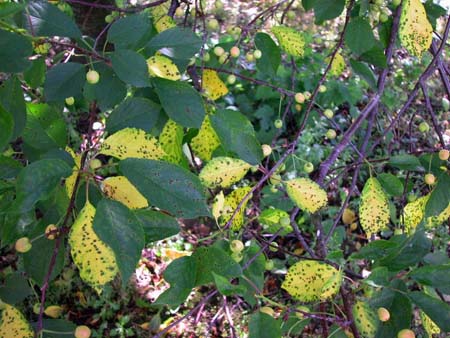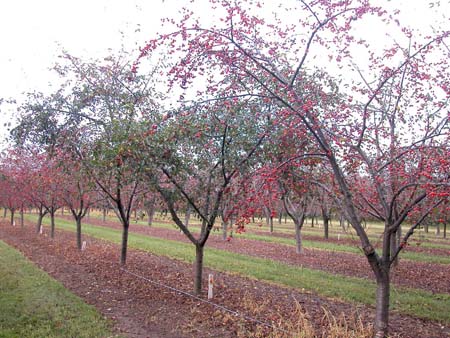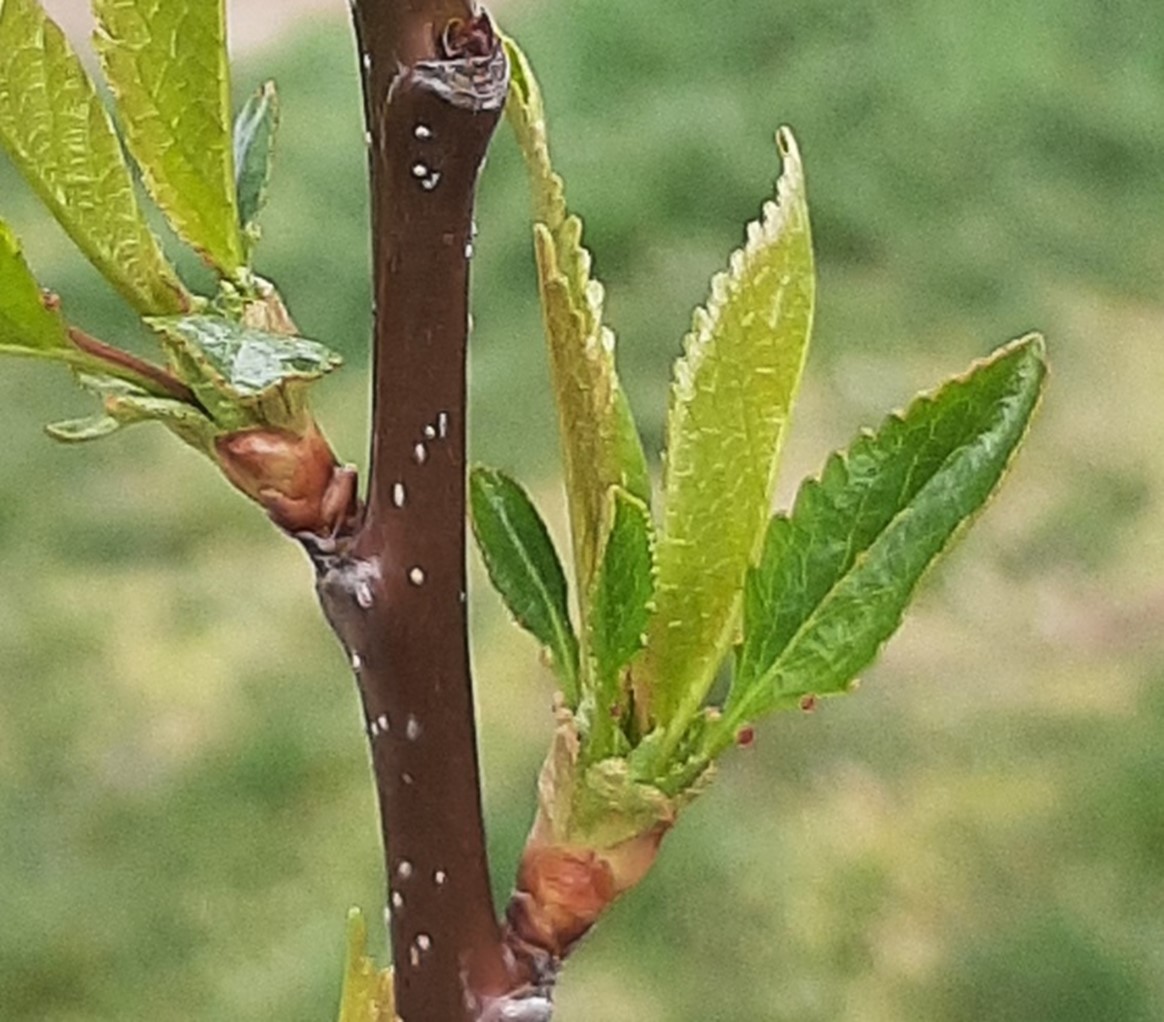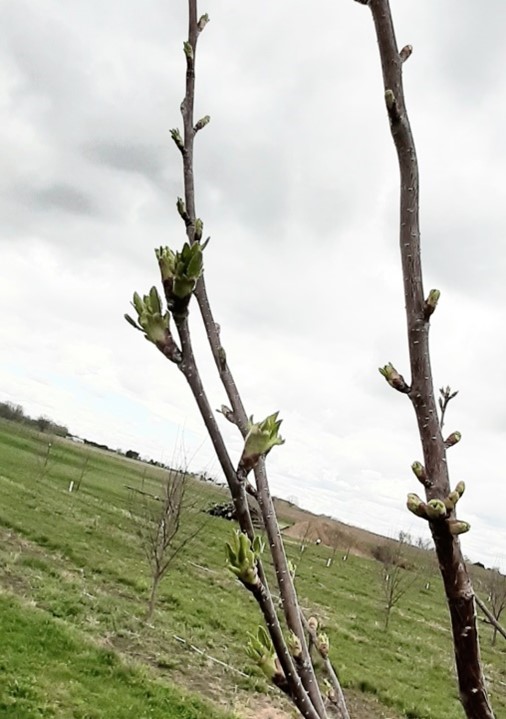Cherry leaf spot 101: Understanding Blumeriella jaapii biology and management
Cherry leaf spot causes significant economic loss in Michigan each year. Management has become more complicated due to the introduction of novel fungicides and resistance issues.

Cherry leaf spot (CLS) is arguably the most damaging fungal disease of tart cherry. Annually, this disease can significantly reduce profit for growers in the Great Lakes region. Cherry leaf spot primarily infects the stomata and reduces the photosynthetic capacity of the tree. Symptoms are more distinct in tart cherries than sweet cherries. Infected tart cherry leaves turn yellow and defoliate prematurely (Photo 1). Sweet cherry is much less susceptible to CLS. Leaves can yellow when infected, but leaf drop is uncommon. For both sweet and tart cherries in Michigan, orchards should have at least 50% of their leaves by mid-September to maintain a healthy tree.

Photo 1. Symptoms of cherry leaf spot infection. Photo credit: George Sundin, MSU Department of Plant Pathology
Importance for Control
If significant defoliation occurs before harvest, fruit cannot properly ripen, are soft and immature, have low soluble solids and ripen unevenly throughout the tree canopy (Photo 2). At a minimum, each cherry fruit needs two leaves to ripen properly. A loose assessment of defoliation can be conducted by counting the number of leaves on a limb versus the number of fruits. A limb should have twice as many leaves as fruit. In addition to affecting ripening, early leaf loss reduces the amount of carbohydrate reserves in roots. This can make trees susceptible to winter injury. Bud survival and fruit set may also be reduced for subsequent years after the early defoliation event.

Disease Cycle
Cherry leaf spot is caused by the pathogen Blumeriella jaapii (Rehm). It overwinters on the orchard floor in lesions of infected leaves. In the spring this pathogen forms fruiting bodies called apothecia. Within these structures are sac-like asci containing sexual spores or ascospores. Optimal development of apothecia occurs between 6 to 16 degrees Centigrade (43 to 61 degrees Fahrenheit). Mature asci must be wet for ascospore release to occur. The percentage of ascospores discharged increases with warmer temperatures with the range from 8 to 30 C (46 to 86 F). Spore germination occurs on the surface of new leaves and the fungus enters the leaf through the stomata. It was previously believed that the earliest susceptible tissue was the first leaves around the petal fall stage after bloom. Research has since shown that the infection period can begin prior to bloom, as soon as bract leaves emerge and open from buds (Photos 3 and 4).


Photo 4. Tart cherry bract leaves. Photo credit: Tyre Proffer, MSU Department of Plant, Soil and Microbial Sciences
The primary infection period can last two to six weeks from early bloom, depending on weather conditions. After primary infection, fruiting bodies, develop on the underside of the leaf and produce a visible mass of white spores called conidia. Conidia are dispersed from leaf to leaf by wind or rain and the infection cycle is repeated. Leaves continue to remain susceptible, and this secondary infection cycle can occur multiple times throughout the growing season. Visit Michigan State University’s Enviro-weather web site for more information.
Disease Control
Approximately 95% of tart cherry acreage in Michigan is the cultivar ‘Montmorency’, which is highly susceptible to cherry leaf spot. Fungicides are required to maximize yield and quality. Typically, six to eight applications are recommended per season, depending on disease pressure. Broad spectrum fungicides used to control CLS include chlorothalonil, captan, coppers and dodine. Some CLS isolates present in Michigan are resistant to various single-site fungicides including succinate dehydrogenase inhibitors (SDHIs), demethylation inhibitors (DMIs), and benzimidazoles. The fungal pathogen that causes CLS has a high risk for fungicide resistance. Best practices for managing resistance include rotating fungicides with different modes of action and including multi-site fungicides in the spray program.
Resistance Concerns
Intensive fungicide use is a strong driver for increasing resistant pathogen populations. Even the most effective disease management program will not eliminate all isolates of a pathogen in an orchard. The sensitive portions of the population are killed more easily by a fungicide, but some resistant portions may remain. With repeated use of that same fungicide or another with the same mode of action, the resistant strains will build up. As these isolates become a larger portion of the pathogen population, the level of disease control is reduced. Single-site fungicides that target one site within the pathogen’s metabolic pathway have a higher risk of resistance development. Multi-site fungicides act on several areas of pathogen growth. Pathogens have a more difficult time developing resistance to these multi-action compounds.



 Print
Print Email
Email
